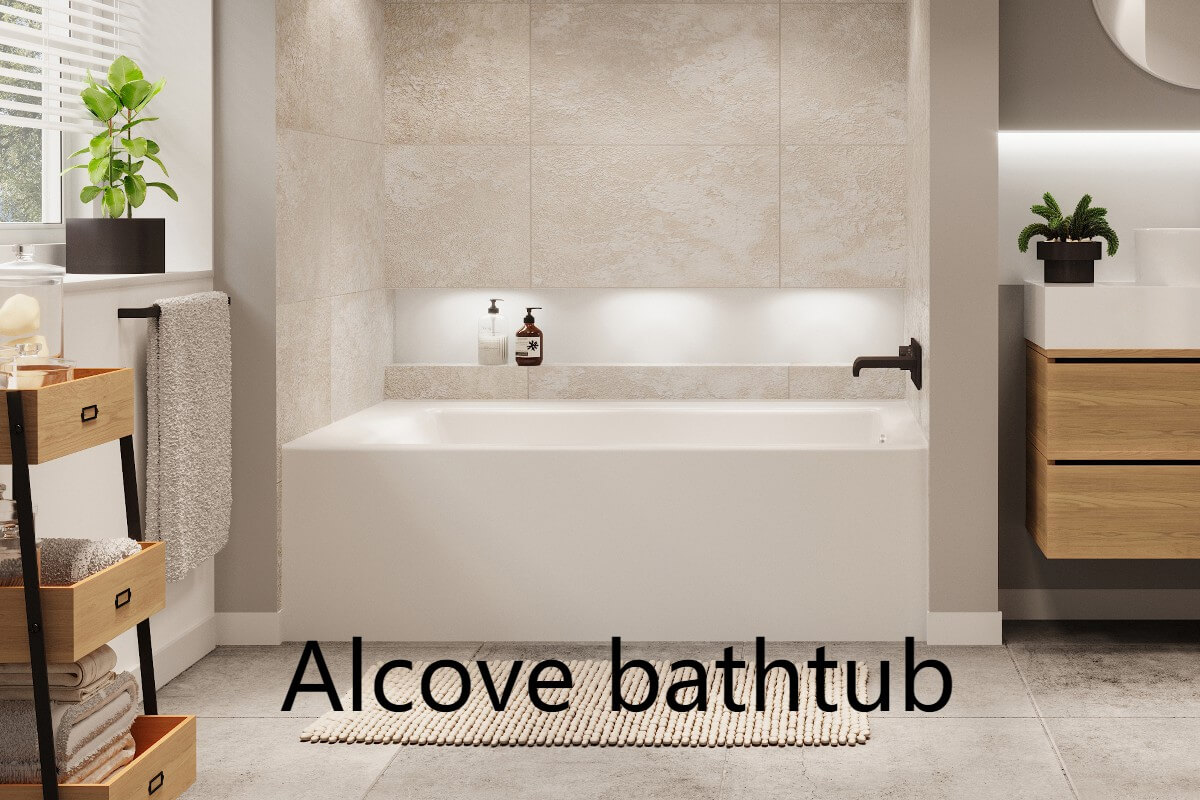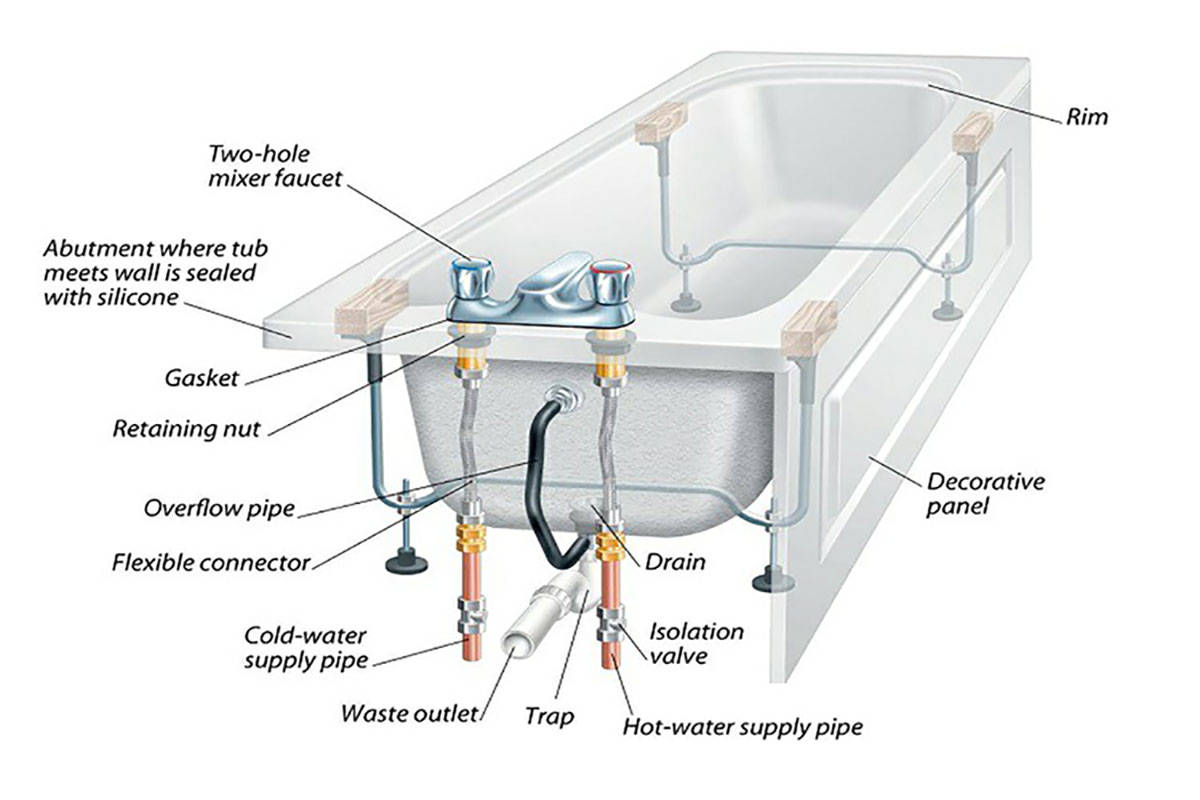Everyone wants to have a perfect bathtub. So how should this be achieved? Don’t worry, in today’s guide we’ll look at how to buy a bathtub, that is, what factors you should consider before buying one. Read on to learn more.
1. How to choose a bathtub?
Here are some factors to consider when buying a bathtub.
1) Bathtub size
First of all, the first thing to consider is the size of the tub you want to buy. You need to choose a suitable bathtub size based on your bathroom space. Not too big and not too small. If your bathroom is large, then you may consider purchasing one in the size you want. If your bathroom is too small, then you may only consider a small bathtub. A standard bathtub is approximately 60 inches long and 32 inches wide.
2) Bathtub shape
The second thing to consider is the shape of the tub. When choosing the shape of a bathtub, consider not just your preference, but also whether the shape is comfortable and will bring you relaxation after a tiring day. If you choose the wrong bathtub shape, you won’t be able to truly experience the joy that a bathtub can bring you.
3) Bathtub weight
Weight is an important factor to consider when purchasing a bathtub. Similar to size, the weight of the tub will determine where it is placed. If the material of the tub is too heavy, your floor and house may not be able to support it when it fills with water. This can be tricky because some of the more premium materials, such as cast iron, natural stone, and copper, are very popular but are often too heavy for many homes.
(Another related post: A Buying Guide for Freestanding Bathtubs)
4) Bathtub height and depth
The above considerations about the size of the bathtub are all to make your bathroom better prevent the bathtub. The height and depth of your bathtub are no different. The depth of the tub is to see if you can fully soak.
5) Installation location
The placement of your tub is important, depending on the tub style you choose. With a freestanding bathtub, you have a lot of freedom in placing the tub wherever you like. For a recessed bathtub, your bathtub needs to be installed close to the wall or against a corner to ensure stability.
As mentioned before, where the tub is placed can also affect safety and accessibility. Install the bathtub close to a wall or in a corner where it will be easier for young children or the elderly to use it. For freestanding bathtubs, we recommend the use of steps or safety rails to ensure no accidents occur.
6) Bathtub material
Bathtubs come in a variety of materials to choose from. Common bathtubs are usually constructed from acrylic or fiberglass, making the interior as hollow as possible to reduce weight. Stronger, heavier tubs may use metal and enamel. Luxurious modern bathtubs can even be made from natural stone or concrete, although this is a particularly heavy and expensive option. The stronger the material, the more likely the tub will resist damage.
(Another related post: A Complete Guide for Freestanding Tub)
7) Finish material
What color do you want your new bathtub to be, and it should match the theme of your bathroom?
8) Faucets and fixtures
Faucets and fixtures are also part of the bathtub, and with these, the bathtub can be used to its fullest potential.
9) Storage and shelving
Consider whether you need storage shelves around the tub. It can be used to store soap, facial cleanser, or other bath products. This way you can easily access it even while soaking.
10) Drainage pipe
The most humble yet most important step is planning the tub drain. Redesigning sewer lines is a complex and expensive process. Therefore, your best bet is to find a bathtub that has a matching drain. If you have a tub/shower combo, shower head placement is also important.
11) Other factors to consider
Another factor to consider is whether to install bathtub accessories. For example, bath rails and lifestyle. If you are installing a bathtub specifically for the elderly, it is recommended that you consider installing a handle. This can ensure the safety of the elderly.
For seniors, Japanese-style or round bathtubs are popular, or if you want to spend a little more money, many bathtubs can be fitted with walk-in tubs, allowing the occupants to sit comfortably while bathing while still come with handles to prevent slipping. Keep the user’s height and physical limitations in mind when choosing a bathtub, as there are many styles available for people with disabilities.
(Another related post: Bathtub Refinishing FAQ Guide)
2. Common questions to ask when buying a bathtub
Here are some common Questions to Ask Before Buying a Bathtub:
1) What style of bathtub is the most comfortable?
According to most homeowners, the most comfortable style is an alcove bathtub because it is designed to create a feeling of comfort when you enter it. That is, what is comfortable for one person may not be comfortable for someone else.
2) What are the most popular bathtub styles?
The most popular bathtub style is the alcove style, mainly because of its design. Other popular models are wooden bathtubs, whirlpool bathtubs and corner bathtubs. Keep in mind that not all bathtub styles will fit your bathroom and lifestyle.
3) How much does it cost to buy a bathtub?
Just looking at the price tag isn’t enough to immediately tell whether a tub will fit your budget. Having a bathtub in your home comes with other costs that you must be prepared to bear. Tubs range in price from $900 to $14,000—the more elaborate the tub, the more expensive it will be. The good news is that some bathtub materials can retain heat, saving water and electricity. Some tubs are also equipped with cost-effective technology, so you can save money in the long run.
(Another related post: Top 10 Bathtub Manufacturers in 2023)
4) How are you going to use your bathtub?
Your answer determines whether an inexpensive basic design will suffice, or if you need an upgraded, higher-quality tub. For example, a standard soaking tub needs only to be filled with water, while a whirlpool or air bath has nozzles or channels that deliver massaging air. Extras in a soaking tub are usually limited to grab bars or headrests, grab bars, and non-slip floors.
There are even more options for whirlpool, air, or combination baths, including adjustable jets, ambient underwater lighting, aromatherapy functions, heated blowers, and self-cleaning systems. The more elaborate your tub is, the more expensive it will be.
5) How much space do you have?
Before you can fall in love with a particular type of bathtub, you need to know what your bathroom can accommodate. Standard tubs are 60 inches long, 30 inches wide, and 14 inches deep, but there are many other sizes and shapes available.
To determine how big your tub is, take careful measurements of your bathroom and doorways. Make note of where the drain will go on the floor to make sure it will work with your chosen tub design. Also, some bathtubs do not allow a shower, so check to see if a tub-shower combination is a must-have feature for your home before buying.
6) Are there any special precautions for bathtub installation?
If you’re considering a jetted tub, you need to plan for a water pump, air switch, and electronic timer. Many pumps are installed inside the tub unit, but some manufacturers have remote pumps that can be placed up to 5 feet away from the tub and hidden in a closet or vanity. A non-electric air switch may be located on the tub unit. Plan to install the electronic timer a safe distance (at least 5 feet) from the bathtub to meet bathroom code requirements.
(Another related post: Bathtub Refinishing VS. Bathtub Reglazing: What is the Difference?)
7) Is your water heater up to the task?
The size of your bathtub can affect your monthly expenses. A typical bathtub is one-third cold and two-thirds hot. If you have a hot water tank, does it provide enough hot water? Tubs vary in size and hold 25-150 gallons of water. Make sure your water heater is large enough to fill about two-thirds of the tub with warm water.
8) Have a problem with your weight?
Plastic tubs weigh as little as 50 pounds, while cast iron tubs can weigh up to 1,000 pounds. If you are considering heavier materials, can your floor handle the weight? When you add up the weight of the tub, plus the weight of the water and the person, it may be necessary to reinforce the floor beneath the tub with braces or braces. Also, a bathtub that is too heavy may not fit into a second-floor bathroom or be prohibitively expensive.
9) Is the bathtub comfortable?
Before you buy a tub, try it on for size—literally. Climb in, sit down, and imagine yourself soaking in the water. Does it fit you and make you feel comfortable? Don’t be embarrassed; this is the best way to find out if you are satisfied.
10) Should I repair or refinish my bathtub?
If your tub is leaking, cracked, or worn, it may be time to replace it. However, maybe the nature of your old tub—or the daunting task of removing it—doesn’t justify a replacement. Unsightly chips and stains can be fixed by refinishing or lining your tub. Some bathtub manufacturers can refinish your bathtub with a polyurethane coating that gives it a hard, high-gloss finish. Other companies can outfit your tub with an acrylic liner molded to its exact size, shape, and style.
(Another related post: How to Repair Chips & Cracks in Bathtub?)
3. Conclusion
This is our summary of the factors to consider when buying a bathtub and answers to frequently asked questions. Follow these steps to find the right bathtub for you. If you have any further questions, please consult Nicemoco.
How useful was this post?
Click on a star to rate it!
Average rating 5 / 5. Vote count: 5
No votes so far! Be the first to rate this post.








